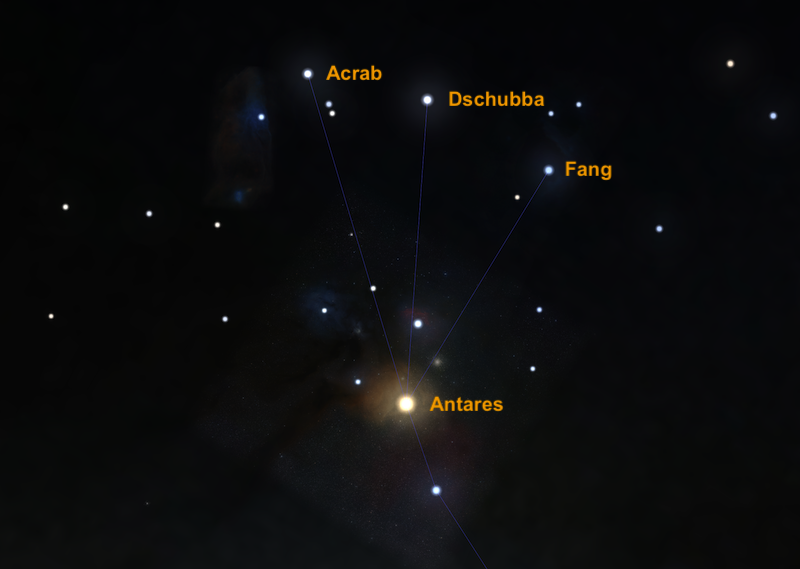
Scorpion’s Crown and associates
Scorpius the Scorpion is one of the easiest constellations to see in the sky. It is, in fact, a large J-shaped figure. The bright red star Antares lies at the Scorpion’s heart. Likewise, a curved arc of three stars – Acrab, Dschubba and Fang – mark the Scorpion’s head. They’re known as the Crown of the Scorpion. The upper part of Scorpion – Antares at the heart, and the three stars at the Crown – are beautiful to look at and fascinating to contemplate. Also, Antares and these three stars are part of a nearby grouping of young stars known as the Scorpius–Centaurus Association.
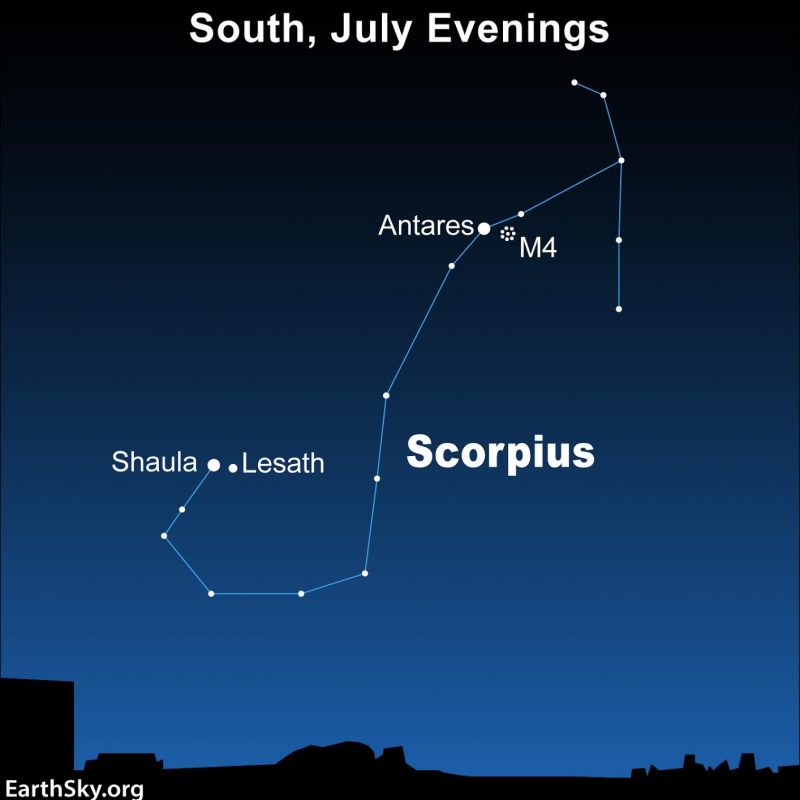
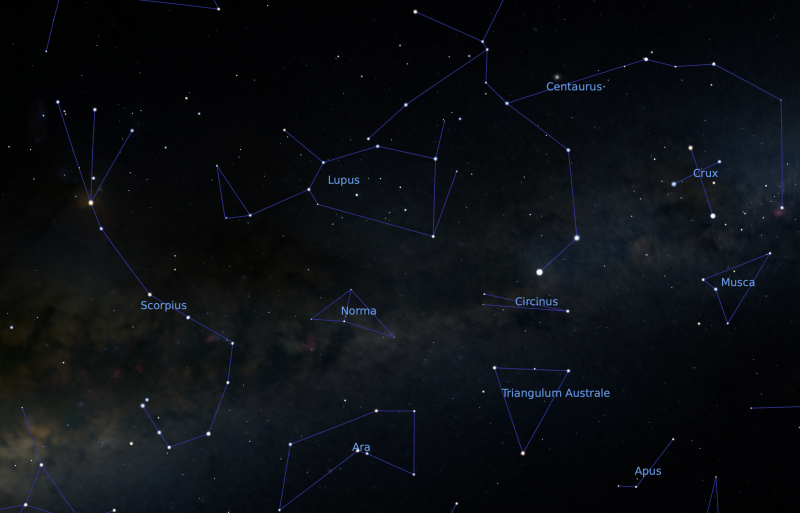
Young stars born from the same cloud
The Scorpius–Centaurus Association is an OB association. Generally speaking, that’s a term astronomers use to describe a collection of young stars formed from the same giant cloud of dust and gas. Indeed, most stars in our galaxy formed this way, without much in the way of gravitational bonds to each other. This is in contrast to stars that form in more compact gravitationally-bound open or globular star clusters. Observations of these associations provide scientists with a deeper understanding of how stars form and evolve. However, they can be a challenge to study because member stars, at least the ones relatively close to us, cover a large area in the sky.
Members of the Scorpius–Centaurus Association are, on average, about 420 light-years away. Moreover, they appear in several southern constellations, including the upper part of Scorpius, Centaurus the Centaur, Lupus the Wolf and Crux the Southern Cross. This association is of great interest to astronomers because it’s the nearest OB association to us. In Scorpius, members of the association, known as Upper Scorpius, may be just 11 million years old (this is very young in the range of stellar lifespans) while other members of the Scorpius–Centaurus Association range to as much as 15 million years in age.
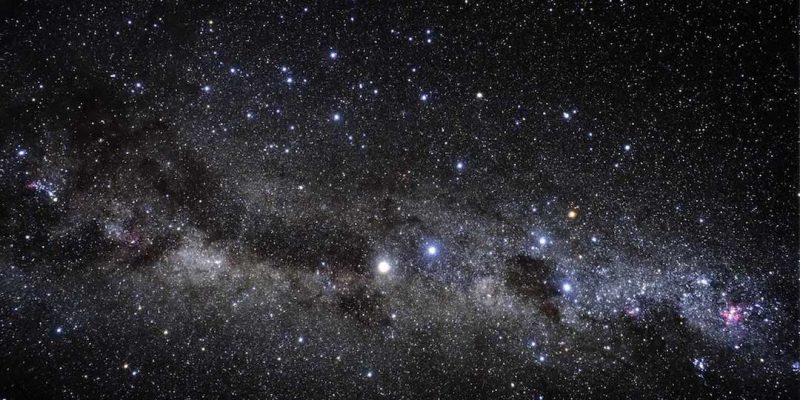
The stars and their distances and temperatures
Astronomers have directly measured distances for over 400 brighter members of the Scorpius–Centaurus Association. In addition, they have identified much fainter, lower mass, stars from spectroscopic surveys. Overall, the exact number of stars in this association remains unknown but it’s likely in the few thousands.
Most stars visible to us are massive hot blue stars, like those in the Scorpion’s Crown. For example, the largest star in the Upper Scorpius sector is Antares, with a mass almost 15 times that of our sun. However, the masses of stars in the association run the gamut from very massive stars to very low mass brown dwarf stars.
Generations of stars: Dead stars cause new star birth
Much larger stars once existed throughout the Scorpius–Centaurus Association. They’re now long gone, having exploded as supernovae. Still, they continue to be important players in subsequent star formation. Indeed, these supernovae left ghostly traces of their presence – bubble-like cavities within the cloud complexes – when powerful shockwaves from the explosions initially swept through the massive molecular cloud. Farther away from the supernovae, the shockwaves, their power a bit muted from traveling large distances, passed through some cloud regions. Thus, triggering new rounds of star formation as their energy compressed dust and gas in their paths.
On his website, astronomer Thomas Preibisch wrote about the Scorpius-Centaurus Association’s possible history. (Some dates written here are modified based on new research). About 15 to 17 million years ago, star formation began in a region of the massive cloud located in what is today’s constellations of Centaurus and Lupus. Then, around 12 million years ago, a very massive star in that region exploded as a supernova, creating a tremendous shockwave. Finally, about 11 million years ago, energy from that shockwave reached molecular clouds in the upper part of Scorpius, triggering star formation. That’s how the Scorpion Crown stars and Antares were born.
Supernova in Scorpion’s crown triggered a shockwave
Massive stars in this new family emitted powerful ultraviolet radiation and stellar winds that cleared out much of the remaining cloud material, putting a stop to further star formation. However, the most massive star of that family exploded as a supernova, sending out another shockwave. Now, that shockwave is moving through a neighboring cloud complex, called Rho Ophiuchi, triggering another cycle of star formation.
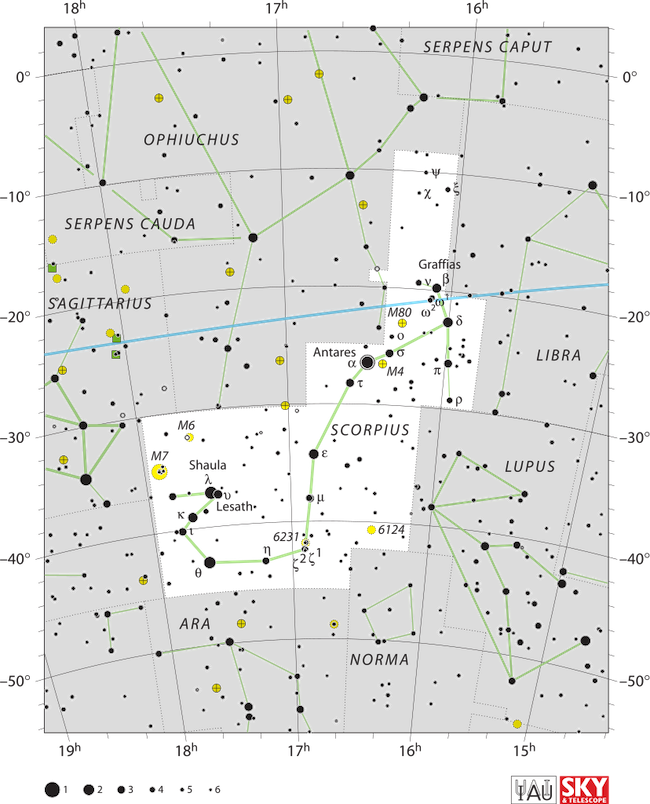
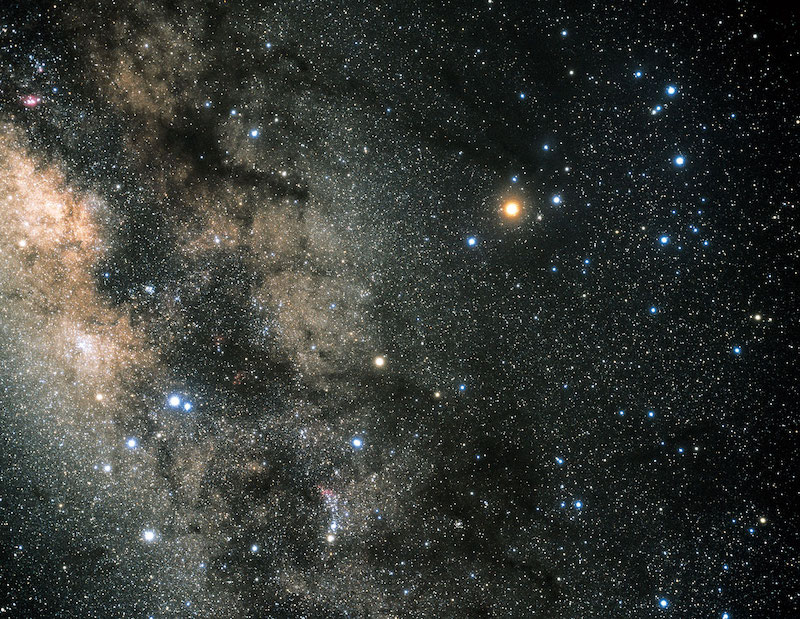
Bottom line: The three stars that make up the head of Scorpius the Scorpion are part of a young collection of stars formed from the same cloud of gas and dust, called the Scorpius-Centaurus Association.
The post The Scorpion’s Crown and its stellar neighborhood first appeared on EarthSky.
from EarthSky https://ift.tt/M13uhyc

Scorpion’s Crown and associates
Scorpius the Scorpion is one of the easiest constellations to see in the sky. It is, in fact, a large J-shaped figure. The bright red star Antares lies at the Scorpion’s heart. Likewise, a curved arc of three stars – Acrab, Dschubba and Fang – mark the Scorpion’s head. They’re known as the Crown of the Scorpion. The upper part of Scorpion – Antares at the heart, and the three stars at the Crown – are beautiful to look at and fascinating to contemplate. Also, Antares and these three stars are part of a nearby grouping of young stars known as the Scorpius–Centaurus Association.


Young stars born from the same cloud
The Scorpius–Centaurus Association is an OB association. Generally speaking, that’s a term astronomers use to describe a collection of young stars formed from the same giant cloud of dust and gas. Indeed, most stars in our galaxy formed this way, without much in the way of gravitational bonds to each other. This is in contrast to stars that form in more compact gravitationally-bound open or globular star clusters. Observations of these associations provide scientists with a deeper understanding of how stars form and evolve. However, they can be a challenge to study because member stars, at least the ones relatively close to us, cover a large area in the sky.
Members of the Scorpius–Centaurus Association are, on average, about 420 light-years away. Moreover, they appear in several southern constellations, including the upper part of Scorpius, Centaurus the Centaur, Lupus the Wolf and Crux the Southern Cross. This association is of great interest to astronomers because it’s the nearest OB association to us. In Scorpius, members of the association, known as Upper Scorpius, may be just 11 million years old (this is very young in the range of stellar lifespans) while other members of the Scorpius–Centaurus Association range to as much as 15 million years in age.

The stars and their distances and temperatures
Astronomers have directly measured distances for over 400 brighter members of the Scorpius–Centaurus Association. In addition, they have identified much fainter, lower mass, stars from spectroscopic surveys. Overall, the exact number of stars in this association remains unknown but it’s likely in the few thousands.
Most stars visible to us are massive hot blue stars, like those in the Scorpion’s Crown. For example, the largest star in the Upper Scorpius sector is Antares, with a mass almost 15 times that of our sun. However, the masses of stars in the association run the gamut from very massive stars to very low mass brown dwarf stars.
Generations of stars: Dead stars cause new star birth
Much larger stars once existed throughout the Scorpius–Centaurus Association. They’re now long gone, having exploded as supernovae. Still, they continue to be important players in subsequent star formation. Indeed, these supernovae left ghostly traces of their presence – bubble-like cavities within the cloud complexes – when powerful shockwaves from the explosions initially swept through the massive molecular cloud. Farther away from the supernovae, the shockwaves, their power a bit muted from traveling large distances, passed through some cloud regions. Thus, triggering new rounds of star formation as their energy compressed dust and gas in their paths.
On his website, astronomer Thomas Preibisch wrote about the Scorpius-Centaurus Association’s possible history. (Some dates written here are modified based on new research). About 15 to 17 million years ago, star formation began in a region of the massive cloud located in what is today’s constellations of Centaurus and Lupus. Then, around 12 million years ago, a very massive star in that region exploded as a supernova, creating a tremendous shockwave. Finally, about 11 million years ago, energy from that shockwave reached molecular clouds in the upper part of Scorpius, triggering star formation. That’s how the Scorpion Crown stars and Antares were born.
Supernova in Scorpion’s crown triggered a shockwave
Massive stars in this new family emitted powerful ultraviolet radiation and stellar winds that cleared out much of the remaining cloud material, putting a stop to further star formation. However, the most massive star of that family exploded as a supernova, sending out another shockwave. Now, that shockwave is moving through a neighboring cloud complex, called Rho Ophiuchi, triggering another cycle of star formation.


Bottom line: The three stars that make up the head of Scorpius the Scorpion are part of a young collection of stars formed from the same cloud of gas and dust, called the Scorpius-Centaurus Association.
The post The Scorpion’s Crown and its stellar neighborhood first appeared on EarthSky.
from EarthSky https://ift.tt/M13uhyc

Aucun commentaire:
Enregistrer un commentaire